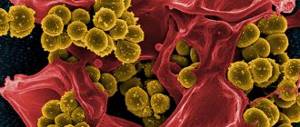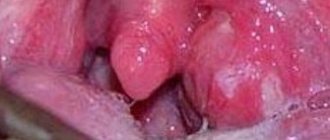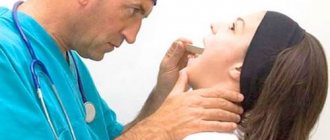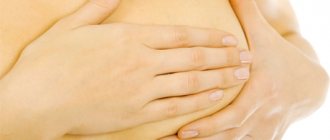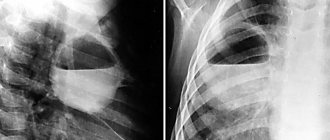Abscess on the buttock
An abscess on the buttocks is an inflammatory process that can occur as a complication after an injection.
This often occurs in medical practice, especially if the injection is given by a person without special qualifications. An abscess appears due to infection of soft tissues by various microorganisms, most often staphylococci. They enter the localization site through an unsterile syringe, untreated hands or other means. First, inflammation develops in the diseased area, then pus forms, surrounded by a capsular bag. This pus must come out, then the abscess is covered with skin.
People with weakened immune systems, those suffering from diabetes mellitus and other systemic diseases are most prone to the appearance of post-injection abscesses.
Patients who receive a large number of injections also have a certain risk. Treatment of an abscess is not particularly difficult.
You just need to maintain good hygiene and use a few home remedies to speed up the removal of pus and promote healing of the skin.
Infiltration after injections: symptoms and causes
Infiltration is a pathology that is important to detect and stop in time. Otherwise, the next step will be an abscess and surgical treatment. Symptoms of post-injection infiltrate do not appear immediately (for example, appendiceal infiltrate forms on days 3-4), so attention is important not only during the injection.
Post-infectious infiltrate has the following symptoms:
- Inflammation;
- Accumulation of blood cells and lymph;
- Compaction of soft tissues;
- Pain when pressed;
- Redness of the skin.
At this stage of complications after the injection, white blood cells are just beginning to absorb “strangers”, so there will be no pus. Purulent fluid is a sign of an abscess. Nursing manuals write that post-injection complications are often the result of errors made by health workers in injection technology.
In practice, 28.5% of complications occur due to self-injections, when in hospitals this figure is 12%.
In case of post-injection complications, you should consult the doctor who did the injection.
Prevention of the formation of infiltrate begins with knowing the causes of the complication. The main factor is ignoring the rules of asepsis and antisepsis. Alcohol 95% and vodka are not suitable disinfectants. Only 70% alcohol (more often called medical alcohol) and chlorhexidine are the only true antiseptics. A dull or insufficiently long needle entails pathological processes in tissues. The injection site must be selected correctly, but constant injections in one place cause post-injection complications. The provoking substances in this area are magnesium sulfate and baralgin (33% and 26% of cases, respectively). Post-injection infiltration depends on the patient’s immunity: in some, complications occur rarely, while in others they are detected after each injection.
Antibiotics and other drugs for conservative treatment
The initial stage of maturation of a purulent-inflammatory formation (furuncle, carbuncle) on the buttock is subject to conservative treatment. Pharmacies sell antibiotics aimed at suppressing the proliferation of parasitic microflora inside the body.
To eliminate the causative agent of the abscess, culture from the pathological area is required. It is carried out at the stage of surgical intervention; purulent contents are sent to the laboratory.
The infiltrate is treated with semisynthetic penicillins, macrolides, cephalosporins, and lincosamides. The course of antibacterial therapy lasts from 7 to 14 days, the dose of the drug is selected according to the body weight of an adult or child. Antibiotics for buttock abscess are a mandatory measure to reduce the risk of complications.
Inflammation on the butt is accompanied by severe discomfort; painkillers are used to relieve the unpleasant symptom. Substances are administered intramuscularly or orally; common drugs include Analgin and Ketorolac.
Infection with bacterial flora, which contributes to the development of an abscess, is accompanied by high body temperature. To combat intoxication syndrome, Ibuprofen and Paracetamol are used.
The buttock with a purulent infiltrate may itch. To reduce the patient's suffering, antihistamine products are prescribed: Tavegil, Suprastin, Loratadine, Erius.
Local treatment of an abscess includes the use of home remedies: honey cake, cabbage leaf, Vishnevsky liniment, Levomekol gel. They draw out pus, help restore skin integrity, and remove inflammation of the buttocks.
The treatment tactics for purulent-necrotic formations change as the patient’s condition worsens.
Diagnostics
As a rule, one examination of the patient is enough for the doctor to make the correct diagnosis. To clarify the extent of damage to the body, OAC, OAM, biochemical urine analysis and microflora culture are prescribed. For chronic manifestations, an ultrasound is prescribed to look at the location and extent of tissue damage.
You should not engage in independent healing, it can cause great harm, and then the treatment of a buttock abscess can take a long time and have disastrous consequences. The best treatment method is surgical, in which the abscess is opened and the contents of the capsule are sucked out with a vacuum aspirator.
When applying a suture, be sure to leave drainage for better washing of the affected area. Proteolytic enzymes are used for this procedure. This allows you not only to wash out the pus, but also to prevent possible new foci of inflammation.
Types of complications from the injection procedure
In the first days after the injection, an infiltrate appears, which is characterized by hyperemia, swelling, pain, the intensity of which depends on the depth of the process. Usually the infiltrate is accompanied by an increase in body temperature and an inflammatory change in the blood. In the near future, the infiltrate either resolves on its own, or can turn into purulent inflammation from the injection - phlegmon or abscess.
Abscess as a type of complication from an injection
The post-injection process is characterized by a fairly rapid limitation of the inflammatory process.
In such cases, the size of the infiltrate during inflammation after the injection gradually increases until a demarcation zone is formed, which will then form into a well-defined demarcation membrane.
In the middle of the abscess, softening of pus develops, which increases towards the periphery.
The skin may become thinner, leading to spontaneous rupture of the abscess.
At the site of inflammation after the injection, hyperemia, swelling, and pain are formed.
During the formation of a pyogenic capsule at the site of the abscess after the injection, the inflammatory and temperature reaction in the blood decreases.
Cellulitis as a type of inflammation from an injection
Phlegmon after an injection is usually a rapidly progressing impregnation of fiber and surrounding tissues with pus, which in some areas are subject to melting. Along the periphery, purulent impregnation of phlegmon at the injection site, which does not have clear boundaries, can pass into the zone of serous infiltration. In this place there is swelling, dense diffuse infiltration, hyperemia, cutting pain, local hyperthermia, and pronounced swelling of the surrounding tissues.
How to treat infiltration after an injection and avoid complications
Complications with post-injection infiltration can be avoided with timely and correct treatment. If you hope for treatment with time, then you will probably have to treat an abscess, and this is exclusively surgical intervention.
Important to remember:
- No mechanical stress - attempts to open the seal can be fatal;
- Tissue compaction is a reason to consult a therapist;
- Taking vitamins is the prevention of many pathologies;
- Immunomodulators help prevent inflammatory processes.
It is forbidden to treat infiltration after an injection on your own.
Treating infiltration is easier than an abscess and can be done using a conservative method. If there is no hint of suppuration, then iodine mesh and Vishnevsky ointment are an acceptable option. After 3 days of procedures, the pathological compaction will resolve.
It is necessary to understand that these treatment methods will not help with the appearance of pus. And treatment with “traditional methods” is equal to aggravation of post-injection complications.
In stationary conditions, when treating infiltrate, electrophoresis or high-frequency treatment is used. If the compaction has affected a large area of soft tissue, then antibiotics are an important part of preventing an abscess. Antiseptic compresses for the first time after the injection will protect you from many complications. Often there are recommendations based on traditional medicine; self-medication complicates the subsequent work of doctors and the responsibility falls on the shoulders of the patient. This often leads to complex forms of inflammation, and sometimes even to amputation.
Treatment
An abscess in the gluteal region must be treated comprehensively. The main direction is surgical opening of the abscess.
An incision is made at the site of the greatest swelling of the skin, the pus is evacuated and necrotic tissue is excised along with the capsule. The surgical wound is washed with antiseptic solutions and then sutured with primary sutures.
During the treatment process, flow-wash drainage is carried out with proteolytic enzymes (trypsin, chymopsin) and sodium hypochlorite.
In addition to local correction, systemic therapy is required, the volume of which is determined by the severity of the patient’s condition. It is necessary to administer antibiotics (taking into account the sensitivity of the pathogen), detoxification agents (Reosorbilact, Neogemodez), and non-steroidal anti-inflammatory drugs.
If the abscess is just forming, i.e., is at the infiltration stage, then there is no point in performing surgical treatment. In this case, against the background of systemic drug correction, physiotherapy is recommended: electrophoresis with proteolytic enzymes, diadynamic currents, UHF.
Prevention
An abscess of the buttock and other area, even in the case of successful and rapid treatment, leaves an unsightly skin scar with deformation of the subcutaneous fat layer in the form of a pit. Therefore, prevention of post-injection complications plays a vital role:
- Compliance with the rules for administering medications. This applies to the dose, speed of administration, frequency and compatibility of drugs in one syringe.
- Compliance with the injection technique: the needle should be almost completely immersed in the soft tissue and reach the muscle.
- Light massage of the injection area for better absorption of the drug.
- Avoid administering medications to the same point.
- Compliance with the rules of asepsis and antiseptics: cleaning the hands of personnel with disinfectants, treating the skin in the injection area before and after the injection with an antiseptic, using disposable, sterile consumables.
- Correct determination of topographic points for needle insertion. It is difficult to administer injections to people with severe obesity, in whom the outer upper quadrant is an area of subcutaneous fat. In this case, choose another injection site.
Post-injection abscess
– this is a limited purulent-inflammatory focus at the site of injection of the drug. An abscess is characterized by the appearance of local swelling and redness of the skin, gradually increasing in the volume of the compaction, an increase in bursting pain, and fluctuation. The diagnosis is made on the basis of anamnesis and clinical picture (the appearance of a purulent-inflammatory focus at the site of intramuscular and intravenous injections), ultrasound data, and MRI of soft tissues. At the infiltration stage, conservative treatment is effective. The formed abscess is opened surgically and drained.
Treatment with folk remedies at home
If after the injection you notice that something has gone wrong and an infiltrate has formed, then do not delay, start acting immediately. Traditional medicine recommends the following:
- Iodine network.
At the injection site, draw a grid - several perpendicular lines. To do this, soak a cotton swab in a bottle of iodine, and then draw an iodine grid. Carry out a similar procedure twice a day, the second time at night.
- Cabbage leaf.
Take a fresh cabbage leaf, cut off the thick veins, and lightly beat the leaf with a kitchen hammer, and then apply the leaf to the site of the infiltration, secure and leave for 5-6 hours. Change the sheet 3-4 times during the day. The effect of the treatment will be enhanced if the cabbage leaf is smeared with honey.
- Burdock leaves.
Grind 5 burdock leaves or rhizome and apply to the abscess for half an hour.
- Plantain leaves.
Take fresh plantain leaves, crush them with your hands and apply them to the abscess.
- Alcohol compress.
Moisten a piece of cotton wool with alcohol or vodka and apply it to the problem area, cover it with film on top and secure it so that the compress does not fall off. Can be done several times a day after the cotton wool has dried. Similar compresses can be made from mullein or propolis tincture, which can be purchased at the pharmacy. You can use homemade tinctures made from birch buds and Japanese Sophora.
To make the abscess mature faster and release pus, use any of these methods:
- Flatbread made from black bread and honey.
Take the crumb of black bread, crumble it, add a spoonful of honey, mix thoroughly and apply the flatbread to the infiltrate, cover the top with film and tie it.
- Onion.
Boil the peeled onion in milk or bake in the oven. Cut it in half and apply it to the abscess. You can do it differently. Grind a young fresh onion well on a grater or with a blender and apply the pulp to the sore spot for 5 hours, cover with film on top and secure. Repeat several times. Instead of onion gruel, you can use garlic or potato gruel, but only for 3 hours.
- Aloe leaves.
Wash the aloe leaf, cut off the side prickly areas, cut in half and apply the inside to the abscess. Fasten so that the sheet holds well. Leave for several hours.
- Flax or fenugreek seed powder.
Dissolve 1 tbsp in 100 ml of warm water. l. powder. Apply the lotion for half an hour.
Treatment of post-injection infiltration usually occurs at home. Anti-inflammatory drugs or special physiotherapeutic procedures are prescribed to avoid the development of an abscess. In some cases, the doctor recommends the use of antibiotics, especially if the lump at the injection site has reached an impressive size and the temperature has risen.
Physiotherapeutic procedures include electrophoresis and ultrasound.
Options for treating painful bumps on the buttocks after injections include numerous folk remedies that have proven themselves to be effective in the fight against inflammation:
- Iodine mesh - a pattern is made from an alcohol solution of iodine on the affected area, applied for 3 days, after which the lump resolves. Iodine has warming and disinfecting properties.
- Cabbage leaves - they are pierced (cut) to release the juice, applied to the sore spot and secured. They are kept for a day, after which they are replaced; they must be used until the formations completely disappear.
- Honey cake - made from honey, butter, yolk and flour. Warm it up and apply it to the bump, securing it with a band-aid, leave it overnight and replace it again in the morning. The course of treatment is until the formation resolves.
- Aloe leaves are crushed until the juice appears and applied to the sore spot.
- A compress of pickled cucumber, banana peel, crushed fresh cranberries or raw potatoes.
Old formations after injections on the buttocks can be treated as follows:
- A compress of vodka and alcohol in proportions 1:1, left for 2 hours, after and before use, the treatment site is lubricated with baby cream.
- A mixture of vinegar and raw eggs used to make a compress.
- A solution or magnesium - it is smeared on the sore spot.
- Therapeutic emulsion of iodine and analgin.
- Warm compress of honey, butter and egg or honey, alcohol and aspirin.
- Compress made of gauze, generously rubbed with laundry soap.
- If the cones are small, then you can apply the greenhouse effect by wrapping the area with a previously disinfected piece of polyethylene, stationery tape or foil.
Symptoms
The clinical picture of an abscess is quite characteristic. It consists of local and general signs of the inflammatory process. The first include:
- Redness of the skin.
- Painful swelling.
- Increase in local temperature.
First, a dense infiltrate forms in the gluteal area, and as the purulent melting of the tissues occurs, a symptom of fluctuation appears - when you tap your fingers in the center of the swelling, you can feel the vibration of the exudate accumulated in the cavity. Painful sensations first disturb when pressing on the affected area, and then at rest (pulsating, pulling, bursting). In addition, inflammation is accompanied by general symptoms: high fever (up to 40 degrees), malaise, body aches and loss of appetite.
If treatment is not carried out in time, the abscess on the buttock breaks out with the formation of fistulas.
However, pus can spread along the interfascial spaces to other areas, for example, to the thigh, or give rise to serious complications: phlegmon, osteomyelitis, sepsis.
Folk remedies
To eliminate the consequences of injections at home, you can add traditional recipes to the main treatment:
- Applying an iodine mesh to the area of compaction. This should be done 2 times a day (in the morning and before bedtime).
- Applying a cabbage leaf to the inflammation at the injection site. A fresh leaf is separated from the head of cabbage, several small cuts are made to release the juice and applied to the diseased area for several hours.
Treatment of post-injection abscess should begin as early as possible under the supervision of a doctor. Self-medication is dangerous due to deterioration of the condition and possible complications.
The doctor makes a decision on the methods and tactics of treating an abscess after an injection based on the results of tests and culture.
How to treat infiltration after an injection and avoid complications
Complications with post-injection infiltration can be avoided with timely and correct treatment. If you hope for treatment with time, then you will probably have to treat an abscess, and this is exclusively surgical intervention.
Important to remember:
- No mechanical stress - attempts to open the seal can be fatal;
- Tissue compaction is a reason to consult a therapist;
- Taking vitamins is the prevention of many pathologies;
- Immunomodulators help prevent inflammatory processes.
It is forbidden to treat infiltration after an injection on your own.
Treating infiltration is easier than an abscess and can be done using a conservative method. If there is no hint of suppuration, then iodine mesh and Vishnevsky ointment are an acceptable option. After 3 days of procedures, the pathological compaction will resolve.
It is necessary to understand that these treatment methods will not help with the appearance of pus. And treatment with “traditional methods” is equal to aggravation of post-injection complications.
In stationary conditions, when treating infiltrate, electrophoresis or high-frequency treatment is used. If the compaction has affected a large area of soft tissue, then antibiotics are an important part of preventing an abscess. Antiseptic compresses for the first time after the injection will protect you from many complications. Often there are recommendations based on traditional medicine; self-medication complicates the subsequent work of doctors and the responsibility falls on the shoulders of the patient. This often leads to complex forms of inflammation, and sometimes even to amputation.
Complications
Cellulitis (purulent inflammation of the cellular spaces) is one of the most common complications of an abscess after an injection; in more severe cases, the purulent process can be transmitted to the pelvic bones, thigh tissue, and into the pelvic cavity.
Another consequence of an abscess is the opening of fistulas. External fistulas are most favorable, because they rid the body of purulent-necrotic masses, but, unfortunately, fistulas can open into any cavity. When the gluteal region is affected, fistulas into the pelvic cavity and rectal fistulas are most often observed.
One of the most dangerous complications of an abscess after an injection is sepsis (blood poisoning). Timely treatment will help to avoid this process. It manifests itself as high fever, increasing weakness, impaired cardiovascular and respiratory activity, and cerebral edema. There is also a possibility of osteomyelitis.
Post-injection abscess of the buttock is easy to diagnose in the early stages using palpation and questioning the patient. Objective data, as a rule, are sufficient to establish the stage of the process and choose treatment tactics. However, to determine the degree of development of the abscess, it may be necessary to undergo tests, such as: blood (general and biochemical), urine, and culture of the abscess contents for microflora.
How to treat a buttock abscess? The first thing you need to do if the described symptoms occur is to immediately go to your local physician or surgeon. Tissue destruction occurs quickly, increasing the area of infection, so treatment must begin without delay.
Complications after injections in the form of an abscess should never be ignored. Treatment of a buttock abscess after an injection is based on the severity of the pathological process, as well as depending on the cause that provoked it, as well as on the type of pathogen. Most often, doctors prescribe drugs aimed at suppressing the activity of pathogenic bacteria, which have a wide spectrum of action.
Also, in parallel with this, medications are prescribed for detoxification and pain relief. Unfortunately, such therapy does not always have a favorable outcome. And if the result is not obtained and time is wasted, the patient may develop an extensive necrotic zone or sepsis.
Therefore, in situations where the infiltrate after injection has accumulated in large quantities, the patient will require specific therapy. Let's talk about this in a little more detail. First of all. If the infiltrate has already appeared, then the patient is advised to urgently stop injections into the affected area, and the active phase of treatment begins.
If the disease was detected at the very beginning at the infiltrate stage, you can get by with conservative treatment: physiotherapy, absorbable compresses, for example, with a dimexide solution. If the lump is very painful after injections, the use of anti-inflammatory drugs will help.
With the development of a purulent process, surgical treatment is indicated. The most effective method of treatment is opening the abscess, removing already non-viable tissue and applying a primary suture, followed by vacuum pumping out the purulent masses, then flow-through drainage. Broad-spectrum antibiotic therapy is also prescribed.
Infiltration after injections: symptoms and causes
Infiltration is a pathology that is important to detect and stop in time. Otherwise, the next step will be an abscess and surgical treatment. Symptoms of post-injection infiltrate do not appear immediately (for example, appendiceal infiltrate forms on days 3-4), so attention is important not only during the injection.
Post-infectious infiltrate has the following symptoms:
- Inflammation;
- Accumulation of blood cells and lymph;
- Compaction of soft tissues;
- Pain when pressed;
- Redness of the skin.
At this stage of complications after the injection, white blood cells are just beginning to absorb “strangers”, so there will be no pus. Purulent fluid is a sign of an abscess. Nursing manuals write that post-injection complications are often the result of errors made by health workers in injection technology.
In practice, 28.5% of complications occur due to self-injections, when in hospitals this figure is 12%.
In case of post-injection complications, you should consult the doctor who did the injection.
Prevention of the formation of infiltrate begins with knowing the causes of the complication. The main factor is ignoring the rules of asepsis and antisepsis. Alcohol 95% and vodka are not suitable disinfectants. Only 70% alcohol (more often called medical alcohol) and chlorhexidine are the only true antiseptics. A dull or insufficiently long needle entails pathological processes in tissues. The injection site must be selected correctly, but constant injections in one place cause post-injection complications. The provoking substances in this area are magnesium sulfate and baralgin (33% and 26% of cases, respectively). Post-injection infiltration depends on the patient’s immunity: in some, complications occur rarely, while in others they are detected after each injection.
Intervention stages:
- Formation of the primary seam.
- Enzymatic necrolysis.
- Vacuum aspiration of pus using drainage.
- Subsequent flow-wash drainage using sodium hypochlorite and proteolytic enzymes.
The last stage helps prevent secondary infection. This closed method of treatment promotes rapid healing of tissue affected by an abscess.
The previously used method of open treatment without the formation of a primary suture in 30% of cases led to infection of patients. The most common source of infection was Pseudomonas aeruginosa.
Puncture of the abscess of the buttock, which was common previously, is no longer relevant as a method of treatment. Such manipulation provokes complications in the form of phlegmon, purulent streaks, and the process becoming chronic.
Reasons for education.
How does a boil appear if a person feels well and has no special health problems? A bacterium such as Staphylococcus aureus can seriously worsen the condition of the body in a few days.
As soon as a small scratch appears on the body, staphylococcus immediately penetrates there, causing infection. Because of this, boils occur only on sensitive skin, which is most easily susceptible to various irritations.
You can add infection and get a boil not only on the street, but also at home due to the following circumstances:
- Various chronic diseases;
- Lack of vitamins;
- Excessive production of hormones;
- Spending a long time in a place that is too cold or warm;
- Intoxication;
- Deterioration of metabolism;
- Depression, stress and psychological trauma;
- Wrong diet;
- Lack of primary hygiene procedures.

